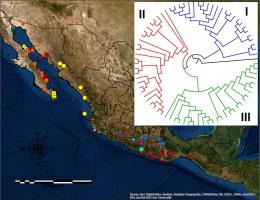Molecular Phylogenetics and Evolution ( IF 3.6 ) Pub Date : 2020-06-06 , DOI: 10.1016/j.ympev.2020.106880 Tonatiuh Ramírez-Reyes 1 , Christopher Blair 2 , Oscar Flores-Villela 3 , Daniel Piñero 4 , Amy Lathrop 5 , Robert Murphy 6

|
We utilize the efficient GBS technique to obtain thousands of nuclear loci and SNPs to reconstruct the evolutionary history of Mexican leaf-toed geckos (Phyllodactylus). Through the incorporation of unprecedented sampling for this group of geckos, in combination with genomic data analysis, we generate mostly consistent phylogenetic hypotheses using two approaches: supermatrix and coalescent-based inference. All topologies depict three, mutually exclusive major clades. Clade I comprises P. bordai and all species closer to P. bordai than to any other Phyllodactylus. Clade II comprises P. nocticolus and all species closer to P. nocticolus than to any other Phyllodactylus. Clade III comprises P. tuberculosus and all species closer to P. tuberculosus than to any other Phyllodactylus. Analyses estimate the age for the most recent common ancestor of Phyllodactylus in the Eocene (~43 mya), and the ancestors of each major clade date to the Eocene-Oligocene transition (32–36 mya). This group includes one late-Eocene lineage (P. bordai), Oligocene lineages (P. paucituberculatus, P. delcampi), but also topological patterns that indicate a recent radiation occurred during the Pleistocene on islands in the Gulf of California. The wide spatial and temporal scale indicates a complex and unique biogeographic history for each major clade. The 33 species delimited by BPP and stepping-stone BFD*coalescent based genomic approaches reflect this history. This diversity delimited for Mexican leaf-toed geckos demonstrates a vast underestimation in the number of species based on morphological data alone.
中文翻译:

植物遗传学和分子种类的划分揭示了叶趾壁虎(Phyllodactylidae:Phyllodactylus)的巨大隐秘多样性,古老的起源和墨西哥的多样化。
我们利用有效的GBS技术获得数千个核基因座和SNP,以重建墨西哥叶趾壁虎(Phyllodactylus)的进化史。通过对这组壁虎进行前所未有的采样,并结合基因组数据分析,我们使用两种方法(超级矩阵和基于合并的推理)生成了大部分一致的系统发育假设。所有拓扑都描绘了三个相互排斥的主要进化枝。克拉德I包含P. bordai和所有物种接近P. bordai比任何其他Phyllodactylus。进化枝II包括P. nocticolus和所有物种更靠近P. nocticolus比任何其他Phyllodactylus。进化枝III包括结核菌(P. tuberculosus),所有物种都比结核菌(Pyllodactylus)更靠近结核菌(P.lodactylylus)。分析估计始新世(〜43 mya)中触毛的最近共同祖先的年龄,每个主要进化枝的始祖日期到始新世-渐新世过渡(32-36 mya)。该组包括一个晚新世世系(P. bordai),渐新世世系(P. paucituberculatus,P。delcampi)),以及表明最近的辐射发生在加利福尼亚湾岛屿上的更新世期间的拓扑模式。广阔的时空尺度表明每个主要进化枝都有复杂而独特的生物地理历史。由BPP和基于垫脚石BFD *聚结的基因组方法界定的33种物种反映了这一历史。墨西哥叶趾壁虎的这种多样性表明,仅根据形态学数据,物种数量就被大大低估了。











































 京公网安备 11010802027423号
京公网安备 11010802027423号